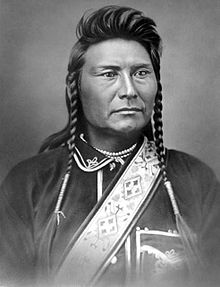Chief Joseph
| Hinmatóowyalahtq̓it (Chief Joseph) |
|
|---|---|

1877
|
|
| Native name | Hinmatóowyalahtq'it |
| Born |
March 3, 1840 Wallowa Valley, Oregon, US |
| Died | September 21, 1904 (aged 64) Colville Indian Reservation, Washington, US |
| Cause of death | "A broken heart" |
| Resting place | Chief Joseph Cemetery Nespelem, Washington 48°10′6.72″N 118°58′37.69″W / 48.1685333°N 118.9771361°WCoordinates: 48°10′6.72″N 118°58′37.69″W / 48.1685333°N 118.9771361°W |
| Other names |
|
| Known for | Nez Perce leader |
| Predecessor | Joseph the Elder (father) |
| Spouse(s) |
|
| Children | Jean-Louise (daughter) |
| Parent(s) |
|
| Relatives |
|
| Signature | |
 |
|
Hin-mah-too-yah-lat-kekt, Hinmatóowyalahtq̓it in Americanist orthography, popularly known as Chief Joseph or Young Joseph (March 3, 1840 – September 21, 1904), succeeded his father Tuekakas (Chief Joseph the Elder) as the leader of the Wal-lam-wat-kain (Wallowa) band of Nez Perce, a Native American tribe indigenous to the Wallowa Valley in northeastern Oregon, in the interior Pacific Northwest region of the United States.
He led his band during the most tumultuous period in their contemporary history when they were forcibly removed from their ancestral lands in the Wallowa Valley by the United States federal government and forced to move northeast, onto the significantly reduced reservation in Lapwai, Idaho Territory. A series of events that culminated in episodes of violence led those Nez Perce who resisted removal, including Joseph's band and an allied band of the Palouse tribe, to take flight to attempt to reach political asylum, ultimately with the Lakota led by Sitting Bull, who had sought refuge in Canada.
They were pursued eastward by the U.S. Army in a campaign led by General Oliver O. Howard. This 1,170-mile (1,900 km) fighting retreat by the Nez Perce in 1877 became known as the Nez Perce War. The skill with which the Nez Perce fought and the manner in which they conducted themselves in the face of incredible adversity led to widespread admiration among their military adversaries and the American public.
...
Wikipedia
